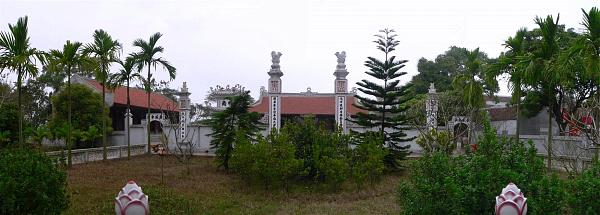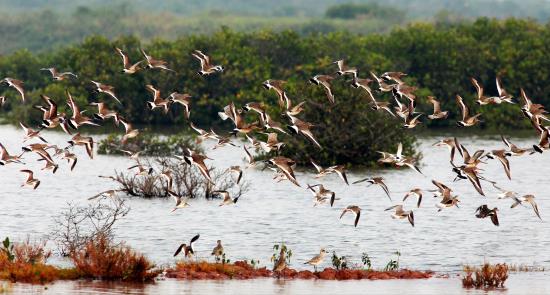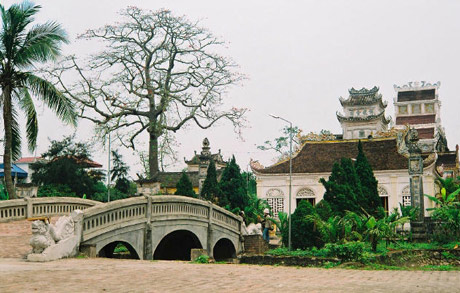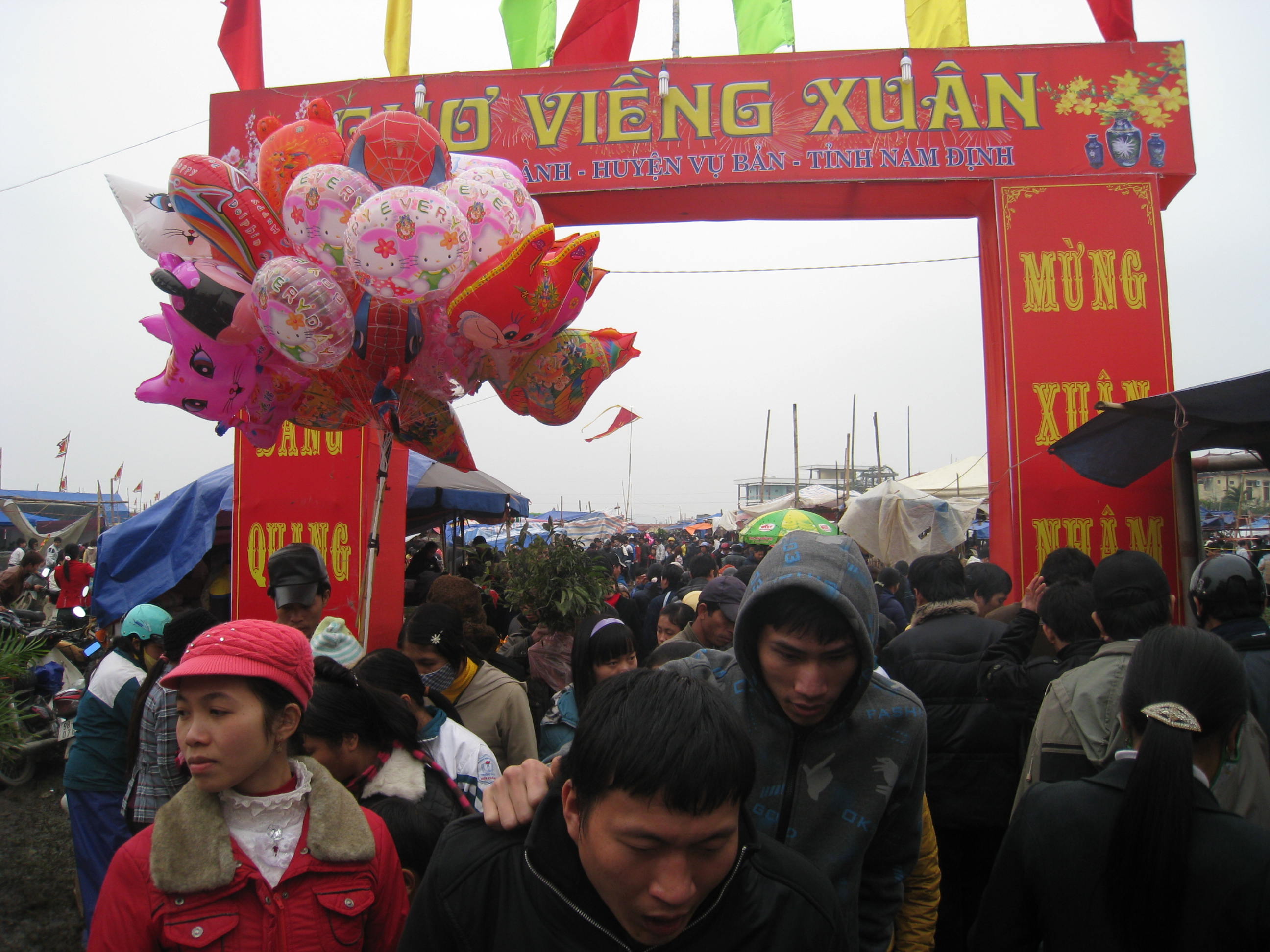Nam Dinh, a coastal province in the southern Red River Delta, is the sacred land of the Viet people, Tran Kings and national hero Tran Hung Dao, the spirit of the Tran Dynasty.
Nam Dinh has nearly 4,000 historical cultural sites including 77 national, 216 provincial ones; and many typically historical, cultural, architectural monuments like Keo Hanh Thien pagoda, Ngoi Bridge, Luong temple, Nam Dinh flagpole.
Nam Dinh is also the native place of Tran dynasty which was the most prosperous in the history of Vietnam feudal era with remains typified by King Tran Relics, Thap temple, Co Le Pagoda, Keo Hanh Thien Pagoda, Phu Day Temple, ect.
In addition, there are historical and cultural monuments associated with famous men like Nguyen Hien (the first doctoral candidate), Luong The Vinh (famous for measuring and intelligence, a sense of humor), Tu Xuong poet memorial house of Nguyen Binh, the memorial site of Truong Chinh, the late General Secretary.
Along with the historical and cultural heritage, Nam Dinh preserved and developed over 70 traditional villages with the industries and products such as the wood carving village of La Xuyen, baamboo lacquer Cat Dang, Tong Xa copper casting village (Y Yen district), Vinh Hao baamboo and rattan village (Vu Ban district), Vi Khe floriculture and ornamental plants (Nam Truc district).
Nam Dinh preserved cultural heritage including typically over 100 traditional festivals held every year. Many unique and great festivals attract tourists such as Phu Day Festivals (national intangible and cultural heritage), the seal opening ceremony at the Tran temple, Vieng fairs, etc.
Below are the mostworthy destinations in Nam Dinh
Tran Temple
Tran Temple in where kings of the Tran Dynasty and their mandarins are worshiped.
The structure has three main buildings, comprising Thien Truong Temple (Up Temple), Trung Hoa Temple (Center Temple), and Co Trach Temple (Down Temple). Thien Truong Temple was established from the base of Trung Quang Palace in which the former King lived and worked.
The first aisle of the temple has the altars and plaques of the Tran Dynasty’s mandarins. The other two aisles in the back are devoted to worshipping the Tran Kings and their ancestors, and the altars of their queens are located at the sides of the interior.
Co Trach Temple is devoted to Tran Quoc Tuan, one of the most famous generals in the history of Vietnam, who had three epic victories for the Tran Dynasty against Mongol invaders. His family and most reliable assistant are memorialized, along with many other mandarins such as Truong Han Sieu and Pham Thien Nhan. 
Trung Hoa Temple is a new building built in 2000 by the local authorities. This temple is used to worship all fourteen Kings of the Tran Dynasty along with their most respected mandarins.
If you visit here on January 15th (lunar calendar) don’t miss the Tran Temple Festival, which celebrates the Tran Dynasty and its famous resistance against three Mongol invasions. This event is also a chance for people to pray for good fortune in their lives, and especially in business.
Tran Temple Festival involves some rituals and cultural activities: proclamation worshipping, palanquin procession, cheo singing, van singing, bai bong dance, sword dance, and wrestling.
Xuan Thuy National Park
Xuan Thuy National Park is located in a 12,000ha area of Giao Thuy District, Nam Dinh. This park is 160km from Hanoi, and is the perfect destination for those who want to explore the wild nature of northern Vietnam and its amazing biodiversity.
Additionally, the place caters to visitors with a multitude of tourist packages and attractions such as community trips or to cultural sites in the surrounding area.
It could be said that Xuan Thuy is one of the best places in the world to see animals in their native habitat, especially birds. Scientists estimate there are over 100 species of migratory birds which stop within Xuan Thuy to rest during their migration, usually in massive flocks.
Besides these migratory birds, there are also 215 species of birds living in its forests and mangrove swamps all year round, including several rare types such as the Pelican, Spoon-bill Stork and Saunder’s Gull. 
Under the waters of Xuan Thuy is a magical habitat of approximately 500 kinds of sea creatures like the Sea Cat, Sea Fox, and many colorful species of crab, shrimp and fish. Moreover, this park contains huge numbers of medicinal and edible plants, including rare kinds of algae and seaweed.
The exceptional biodiversity of Xuan Thuy coupled with its pristine landscapes make for breathtaking views, the kind usually only seen through the lens of a nature documentary.
Pho Minh pagoda 
Pho Minh pagoda is located in Tuc Mac Hamlet, Loc Vuong Commune, Nam Dinh City. The pagoda was built during the Ly Dynasty and was later expanded in 1262 during the Tran Dynasty. It was a place for high-ranking mandarins and the aristocracy of the Tran Royal Court to worship and lead their religious life.
The pagoda was built in the noi cong ngoai quoc style where the inner part was in the form of the Han Chinese ideograph word cong (I) and the outer, the Chinese word quoc. It had clear imprints of the cohabitation of Confucianism, Buddhism and Taoism.
A 7-tonne cauldron, since vanished, once guarded the front and could hold two men. It was dubbed one of the four precious objects of An Nam, joining the Bao Thien Tower, the Quy Dien Bell and Quynh Lam Statue.
The statue of King Tran Nhan Tong lying on his left side shows him entering Nirvana; the statues of the three founders of the Truc Lam Buddhist Sect, Tran Nhan Tong, Phap Loa and Huyen Quang; and 60 red-lacquered and gold-trimmed Buddha and Saint Statues have been preserved in the pagoda.
In particular, a 13 story-tower in the shape of a lotus, 21 meters high, was built within the vicinity of the pagoda in 1305. It is estimated that the 700-tonne tower relies on an area of only 30 square meters but it has remained for 700 years. The base and the tower's first floor were constructed with flagstones and the upper floors were built with bricks.
Thinh Long Beach
Thinh Long is a new beach in Hai Hau, Nam Dinh that has only recently become popular. The beach is 3km of soft sandbanks and Casuarina forest that frames an inlet of sparkling blue ocean.
The scenery at Thinh Long is unequalled by other beaches on the coast of Northern Vietnam, due to its untouched beauty and clean waters. Thinh Long is lucky in that it isn’t affected by the infamous hot winds from Laos, so the weather is cooler with a light but pleasing breeze bringing relief from the hot sun. 
There are also some big but gentle waves, which makes Thinh Long an excellent spot for the beginner surfer. If you like to be more active than just working on your suntan, you can also hire a canoe to ride round the seashore and explore rock islands off the coast.
There are professional fishing villages at each end of the beach which are happy to welcome you and show you their way of life. Don’t forget to taste the special dishes here because this place has wonderfully diverse and delicious seafood, as fresh as it gets!
Co Le pagoda
Co Le pagoda - ancient pagoda with Ly Dynasty architecture - was built by Buddhist Monk Nguyen Minh Khong. It has unique architecture with Cuu Pham Lien Hoa Tower, 9,000-kg bell, ancient Thich Ca Buddha statue, and more.
Buddhist Monk Pham Quang Tuyen rebuilt the existing Co Le Pagoda in November 1920. In front of the pagoda is the 12-storey Cuu Pham Lien Hoa Tower built in 1926. The octagonal base of the tower sits on the back of a turtle facing the pagoda. In the tower, there is a huge staircase spiraling to the top of the tower. From the top, there is a panoramic view of the entire area.
A bridge leads to Phat Giao Hoi Quan, a Buddhist meeting place, built in 1936. In addition to this bridge, the main pagoda can be reached by two other bridges in the mountains. In the center of the pagoda is a large 9,000-kg bell moulded in 1936. In the upper temple is the statue of Thich Ca Buddha; it is made of red lacquer trimmed with gold.
Several rare relics, such as a great red bell and bronze drums dating from the Ly dynasty, are kept in this pagoda.
Vieng Market 
Held in Nam Truc and Vu Ban Districts, Nam Dinh Province, Vieng market festival is launched on the annual 8th day of the first lunar month, only once a year, just after Tet (Lunar New Year) holiday. This is one of the most famous traditional market festivals in Vietnam.
Legend has it that Vieng market is linked to the person who brought copper casting to the area, Nguyen Minh Khong, so people who go the market feel that they will get lucky if they buy something made of copper on this day.
The market opens on the 8th of lunar January; nevertheless, the most spiritual moment falls on the night of the 7th and early 8th. That is the moment of heavenly-earthly, positive-negative exchange. According to the popular belief, at the time, men and Gods reach together and prayers could be perceived more clearly. Trade at the time takes place smoothly. Consequently, there are 40,000-50,000 people coming to the market on the night of 7th.
The market on the night of 7th is called “Cho am phu” (Hades Market). There are about 10,000-12,000 people coming to the market on the following 8th. The market-goers not only enjoy the atmosphere but also bring along the feeling toward Mother, praying for fortune and favorable nature, rich crops, and happy family. They buy and sell for luck in the rest of the year.
Vieng market is typical to an agricultural countryside that is rich in natural products, a kind of radiant open-air “fair” produced by local farmers, especially ornamental plants, specialty crops, subtle craft articles, utensils, bronze and iron-made tools, etc. This spring market displays handicraft products, antiquities and false antiquities, utensils, tools for agriculture production, and many kinds of ornamental plants. Specialties are barbecued beef and “banh day” (sticky rice cake).
The cheapest things at Vieng would be flowers and trees, which bring both the buyer and seller happiness and luck. From around 2a.m, deals are done under the light of candles or flash-lights. Deals are agreed to quickly, as people believe, to keep luck. From 6a.m, local people bring farming tools such as hoes and sickles to sell, which relate closely to their lives. Buyers believe that the tools will bring them health and riches. Vieng market also is also a place to relax. Lovers would find themselves or their happy future here.
Above all, everyone visiting the market wants to buy the burnt veal at any cost, which is considered the indispensable gift from the market from the fair of the Vieng market-goers. Vu Ban people think of folk-songs as a reminder:
Beautiful churches
Diocese of Bui Chu
Nam Dinh is home to many beautiful Roman Catholicchurches.
Diocese of Bui Chu: Located in Xuan Ngoc commune, Xuan Truong district, the church was built in 1885. After more than 100 years, the Diocese of Bui Chu is still majestic and superficial. With a length of 78m, a width of 22m and 15m high, this church hosts many important events.
The diocese is reportedly Vietnam’s first place where Catholicism was introduced by foreign missionaries in 1533. It is also the cradle of Catholicism in the country. French Bishop Pierre Lambert de la Motte, one of the first two bishops of the Catholic Church in Vietnam, founded the first indigenous congregation of Adorers of the Holy Cross in the diocese in 1670.
Phu Nhai church
Phu Nhai Church: The church, located in Xuan Phuong Commune, Xuan Truong District, was first built in 1866 as a small temple, but was later renovated and expanded. It is considered the biggest church of Gothic architecture in Vietnam, with 30m height, 28m width and 80m length. There are 2 bell towers with 44m height, containing 4 bells. It has statues stuck on the surface of the walls or the doors.
Kien Lao church
Kien Lao Church is located in Xuan Tien commune, Xuan Truong district with a length of 75m, 26m wide, 28m high and a 46m high bell tower. On the two sides of the church are lakes and rows of street lights.
Trung Linh Church is located in Xuan Ngoc commune, Xuan Truong district, 1.5 km from the Diocese of Bui Chu. This church was built in 1928 and is very beautiful. This is one of the favorite places of couples to take wedding photos.
Thanh Danh Parish: The church is in Xuan Trung commune, Xuan Truong district. It is famous for carved murals related to the classic reference in the Bible.
Thanh Danh Parish
Nam Dinh Cathedral is located in the heart of Nam Dinh City. The church has a simple design but still exudes serious contemplation.
Hung Nghia Church: This church looks like a castle with fine details. This church is located in Hai Hung commune, Hai Hau district, built in 1927 and renovated in 2000.
Xuong Dien Church: The church is located in the coastal commune of Giao Thuy, Hai Hau province, with tile roofs and wood frame like Buddhist temples in Vietnam. The combination of European-Asian style is familiar to Vietnamese.
Hung Nghia church
An Phu Church: This church is in Bui Chu parish, with quite distinctive architecture. Through the ups and downs of history, wars, and weather, the church fell into disrepair and it was rebuilt in 2007.
Hai Ly ruined church: Although it is seriously damaged, the church on the coast of Hai Ly commune, Hai Hau district is still one of the favorite destinations of tourists.
In the past, the coast of Xuong Dien in Hai Ly commune, Hai Hau district had many large and small churches.

However, over time, seawater encroached on the coast and damaged these churches. Parishioners moved the church deep into the mainland three times to avoid the "invasion" of the sea.
The damaged church on the coast of Xuong Dien named Trai Tim (Heart) has been abandoned since 1996.
The best time to take photos of the church is around 5am or 6pm.
Compiled by Pha Le